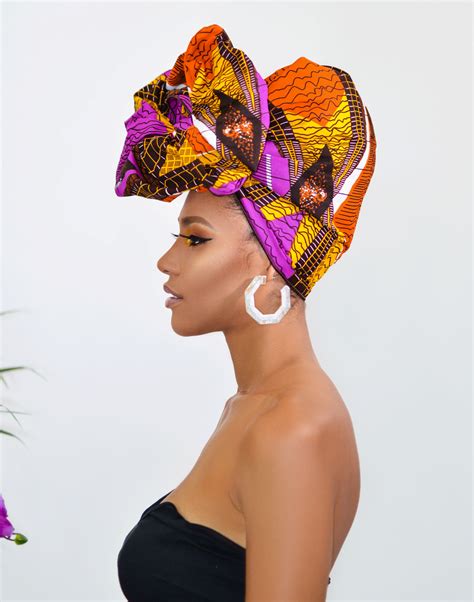Introduction

Across the continent of Africa, there exists a rich tapestry of cultural practices and traditions. Among these, African headwraps stand out as a captivating expression of identity, artistry, and social significance. With their vibrant colors, intricate patterns, and countless styles, these head coverings have become an integral part of the African heritage, transcending generations and inspiring countless individuals worldwide.
The Significance of African Headwraps
Headwraps in Africa serve multiple purposes, both practical and symbolic.
1. Sun Protection: The sweltering African sun necessitates protection from its harmful rays. Headwraps provide shade for the head, neck, and shoulders, preventing sunburn, heatstroke, and other sun-related ailments.
2. Identity and Belonging: Headwraps act as a form of nonverbal communication, denoting cultural affiliation, tribe, and even social status. Different colors, patterns, and tying styles can convey specific messages or indicate a wearer’s origin or family.
3. Spiritual Symbolism: In some African cultures, headwraps are imbued with spiritual significance. They are worn during religious ceremonies, rituals, and prayers as a sign of respect, reverence, and connection to the divine.
4. Empowerment and Expression: For many African women, headwraps are a symbol of empowerment and liberation. They represent a celebration of their cultural heritage, a rejection of Eurocentric beauty standards, and a statement of pride and self-expression.
Different Types of African Headwraps
The diversity of African cultures is reflected in the wide range of headwrap styles found across the continent.
1. Gele: Originating from the Yoruba tribe in Nigeria, the gele is a large, elaborate headwrap made from richly colored fabrics such as damask, velvet, or lace. It is often adorned with beads, sequins, or embroidery.
2. Dukah: Worn by Somali women, the dukah is a triangular-shaped head covering made from soft cotton or silk. It is typically wrapped around the head with the ends draped over the shoulders.
3. Turban: Found in North Africa and the Sahel region, the turban is a long strip of fabric wrapped around the head in multiple layers. It can be made from various materials such as cotton, linen, or wool.
4. Headtie: A versatile headwrap style popular in West Africa, the headtie is a rectangular piece of fabric tied in various knots or styles to create unique and eye-catching looks.
Global Impact of African Headwraps
In recent years, African headwraps have gained global recognition and popularity beyond the African diaspora.
1. Fashion Inspiration: African headwraps have become a source of inspiration for fashion designers worldwide. Their vibrant colors, bold patterns, and innovative styling techniques have influenced everything from haute couture to streetwear.
2. Cultural Exchange: Through the global fashion industry and social media, African headwraps have fostered a greater appreciation for African culture and traditions. They have become a symbol of diversity, inclusivity, and the celebration of Black beauty.
3. Economic Empowerment: The popularity of African headwraps has created a thriving industry for artisans and small businesses. Women in Africa and worldwide are generating income by creating and selling headwraps, empowering them economically and fostering cultural preservation.
Tables
| Table 1: Economic Impact of African Headwrap Industry |
|—|—|
| Value of the Global African Headwrap Market (2023) | $1.5 billion |
| Number of Headwrap Artisans in Africa | Over 1 million |
| Percentage of Women Benefiting from Headwrap Sales | Over 70% |
| Table 2: Importance of Headwraps as a Form of Identity |
|—|—|
| Percentage of African Women Who Wear Headwraps Regularly | Over 80% |
| Number of African Tribes with Unique Headwrap Styles | Over 500 |
| Headwraps as a Symbol of Cultural Continuity | Highly valued and passed down through generations |
| Table 3: Types of Headwraps Worn in Africa |
|—|—|
| Type of Headwrap | Origin | Tying Style |
|—|—|—|
| Gele | Nigeria | Elaborate and ornate; tied with multiple layers and pleats |
| Dukah | Somalia | Triangular shape; wrapped around the head and draped over the shoulders |
| Turban | North Africa and Sahel | Long strip of fabric; wrapped around the head in multiple layers |
| Headtie | West Africa | Versatile style; tied in various knots or styles |
| Table 4: Benefits of Wearing Headwraps |
|—|—|
| Benefit | Reason |
|—|—|
| Sun Protection | Provides shade and protects from harmful UV rays |
| Identity Expression | Conveys cultural affiliation, tribe, and social status |
| Spiritual Significance | Used in religious ceremonies and rituals |
| Empowerment and Liberation | Celebrates African heritage and rejects Eurocentric beauty standards |
| Fashion Statement | Adds vibrancy, color, and unique style to outfits |
Conclusion
African headwraps are more than just pieces of fabric. They are a testament to the rich cultural heritage of the African continent, a symbol of identity and belonging, and a source of empowerment for countless individuals. As the world continues to embrace diversity and inclusivity, African headwraps will undoubtedly continue to captivate and inspire, fostering global appreciation for the beauty and significance of African traditions.
